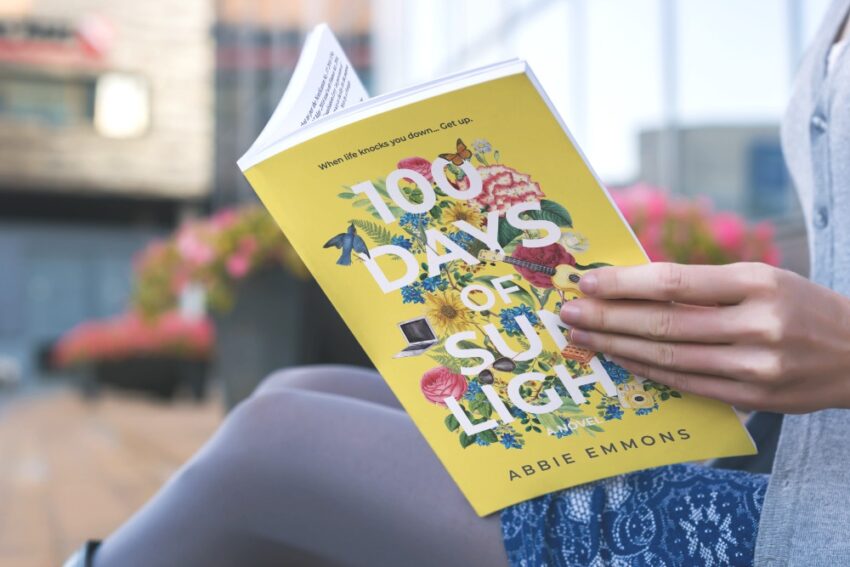Sometimes, characters tend to sound like their author. And I’m not just talking about the way they talk in dialogue (although that could be a problem too!) I mean the fact that, although certain stories are supposed to be written from one or two point of views, oftentimes the very perspective of those characters end up sounding the same. Even if you have a well-developed voice as an author, your characters should still sound different from you and each other. But this is easier said than done.
Have you ever wondered how to fix this problem? Without those handy headers telling your reader who’s speaking at the beginning of each chapter, would they honestly be able to tell which character’s perspective you’re writing from? How can you make sure each character has a distinct voice?
100 Days of Sunlight by Abbie Emmons has just the answer.
100 Days of Sunlight
16-year-old Tessa Dickinson’s world is completely flipped on its head when she gets in a horrible car accident and becomes temporarily blind. Since she can’t see, she can’t continue blogging, either. That is, until her Grandparents hire a teenage boy, Weston, to type for her.
Weston makes it his personal goal to cheer Tessa up and make her life better. He lost his legs at the age of thirteen, so he’s had his fair share of trials, too, and is determined to show Tessa that there can be joy even in the midst of suffering. Although she is annoyed at first, Tessa slowly grows accustomed to Weston’s optimism, and together they find a way to be happy despite the brokeness around them.
This book is written from both Tessa and Weston’s perspective. Since they are very different people with very different outlooks on life, we’re going to do a deep dive into each of their POV’s to discover the best way to write distinct character voices:
Weston + Tessa
Observe this snippet, written from Weston’s perspective:
The trick about stealing flowers from your mother’s garden is minimizing the appearance of damage. You don’t take the flowers she always points out and compliments—you cut the ones she never seems to notice, flowers that are almost like ground cover.
On the morning of June twenty-third, that’s what I’m doing: picking flowers—lily of the valley—in my backyard. After I’ve collected a small bunch of them, I walk to 52 West Elm Street.
Mrs. Dickinson answers the door, like always. She smiles when she sees me.
“Is Tessa awake?” I ask before I even say hello.
Weston starts the chapter with a clever quip of advice for stealing flowers. Then, it goes on to give highly specific details about what he’s doing and where he’s going and when he’s doing it. Then, he forgets his manners and immediately asks where Tessa is. All of these traits are unique from Tessa’s voice. Her writing has a completely different tone, as we can see from the snippet below:
Weston smells like flowers.
It’s weird, but it’s true.
My room fills with the perfume of summer blossoms. I know it didn’t smell like that until Weston came in.
What on earth?
I frown, puzzled, as he sits down at my desk and opens my laptop.
Yes, it’s difficult to face the reality that someone is touching my laptop—a boy, no less. A sixteen-year-old boy, with germs that only belong to the male of the species.
It also bothers me that I can’t see him. I want to know what he looks like, but I can’t ask him. I can’t even ask Grandma, because she’ll think I have some other reason for wanting to know. She’ll think I like him, or something. I don’t know what she’ll think. But I can’t ask. It’s too awkward.
Tessa’s writing is more fluent, more like reading poetry. She doesn’t seem to have any specific details to include, just general description and her own thought process as the scene plays out. You can also detect her sarcasm and instant dislike of Weston just because he’s a boy. And in the final paragraph, unlike Weston, she does mind her manners and is careful to make sure she doesn’t blurt out an awkward question about Weston’s looks.
These two perspectives stay consistent and distinct throughout the entire story, whether the scene they’re in is happy, sad, or simply narrative.
How Did The Author Do This?
Although it does certainly help that Weston is able to see while Tessa isn’t, there’s something deeper than that driving each of their perspectives. Their outward character traits have nothing to do with how they see the world. The specific situation they’re in shouldn’t drastically affect their voice either. Instead, base your character’s unique point of view on their personality traits.
Think of one of your characters. What are they like? Are they generally optimistic or pessimistic? Excited or Depressed? Do they have a keen sense of smell, or do they especially enjoy bright colors? Are they orderly and punctual, or messy and careless? Do they read and write often, or did they receive vocabulary from the streets they grew up on? All of these will affect how they see the setting, the events in their life, and even the other characters around them. Pick one of your characters and come up with a list of these traits. That way, next time you’re writing from their POV, you’ll be able to look back at that list and remind yourself of how you want to portray their unique voice.
Then, once you have that list of traits, apply that to the way they act, talk, and think. Slip some optimism into their dialogue as they reflect on a difficult situation. Show them being careless with their words. Make their prideful attitude clear as they talk down to others and then inwardly congratulate themselves for being awesome afterward. Gradually import that list of personality traits into their perspective, and the reader will instantly be able to know who’s talking.
Another way to ensure your character’s perspectives are unique from each other, is to make them vastly different. A few weeks ago, we talked about how giving your characters similarities can be a good thing, but when it comes to writing from their perspective, it’s best to give them plenty of differences as well. Especially if you’re trying to juggle multiple perspectives at once, it’s best to make them as different as possible. Tessa and Weston aren’t complete opposites, yet they still have so many varying opinions and life experiences so it’s not hard to tell when the POV changes. Give your cast a variety of backgrounds, experiences, and traits, so that way each perspective will be unique and understandable.
Although your character’s point of view might change over the course of the story, although the mood of the scene may vary, give them a consistent, unique perspective on life. Then, let that perspective shine through by the way they act, talk, and their inner dialogue. Don’t let your character’s voices blur together, but instead assign each one a list of personality traits that gives them a unique voice. Spread out varying opinions and experiences, and through a cast of unique perspectives, your story will gain a voice of its own.



Let us know:
Is your current WIP a multi-point-of-view story? What words would you use to describe each of your characters’ perspectives?


Hello, I’m Sophia! I’m a child of God and I (if you couldn’t tell already) love to write! I’m also a total theater kid and strong dessert (specifically cupcake) enthusiast. For as long as I can remember, I’ve enjoyed both reading and making my own stories. I’m so glad I get to share with you what I’ve learned from some of my favorite (or sometimes least favorite) stories on this blog.


Hi Sophia! You’ve got some great tips here. Love it!
I’m commenting to let you (and Mara) know that you’ve been nominated for the Sunshine Blogger Award! Here’s a link to my post with more information: https://emmibookwyrm.substack.com/p/emilys-sunshine-blogger-award
Thank you so much! And thanks for letting us know! We’ll be sure to check this out. (: